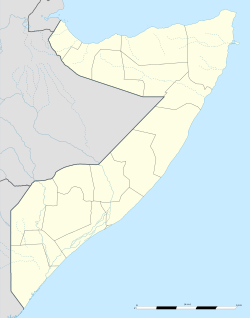
THE HISTORY OF SOMALI DIR CLAN: TAARIKHDA BEESHA DIREED DIR
Monday, April 30, 2018
Sunday, April 29, 2018
The Gadabuursi Dir Script or Borama alphabet - Farta iyo Qoraalkii Gadabuursiga iyo Yusuf Al Kowniin (Kaweyn) . And Yusuf Alkownin Wadaad Writing


The Borama alphabet (Borama: Boorama.jpg) or more generally
known as the Gadabuursi script,[1] is a writing script for the Somali language.
It was devised around 1933 by Sheikh Abdurahman Sh. Nur of the Gadabuursi
clan.[2]
Though not as widely known as Osmanya, the other major
orthography for transcribing Somali, Borama has produced a notable body of
literature mainly consisting of qasidas.[3]
A quite accurate phonetic writing system,[2] the Borama
script was principally used by Nuur and his circle of associates in his native
city of Borama.
I.M. Lewis (1958), The Gadabuursi Somali Script, Bulletin of
the School of Oriental and African Studies, University of London, Vol. 21, pp.
134–156.
David D. Laitin, Politics, language, and thought: the Somali
experience, (University of Chicago Press: 1977)
Somali (af Soomaali / اَف صَومالي˜)
Somali is a member of the East Cushitic branch of the Afro-Asiatic language family. It is spoken mainly in Somali, and also in Djibouti and Ethiopia. In Somali it is an offical language, in Djibouti it is a national language, and it is a working language in the Somali Region of Ethiopia. In 2015 there were about 15 million Somali speakers.Somali has been written with a number of different scripts, including an Arabic-based abjad known as Wadaad's writing, a Latin-based alphabet and the Borama, Osmanya and Kaddare alphabets. The current official script for Somali is the Latin alphabet.
Wadaad's writing (وَداد)
The Arabic script was first introduced in the 13th century by Sheikh Yusuf al-Kowneyn to aid Koranic teaching. In the 19th century Sheikh Uways al-Barawi improved the writing of Somali with the Arabic script and based it on the Maay dialect of Southern Somalia. A Somali linguists, Muuse Xaaji Ismaaciil Galaal, radically altered the spelling conventions for Somali written with the Arabic script and introduced a set of new symbols for the vowels in the 1950s.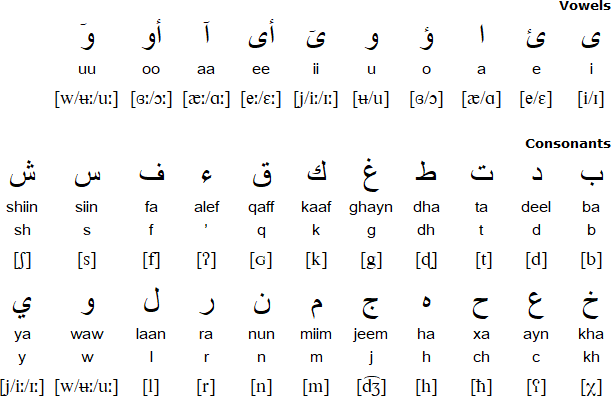
Sample text
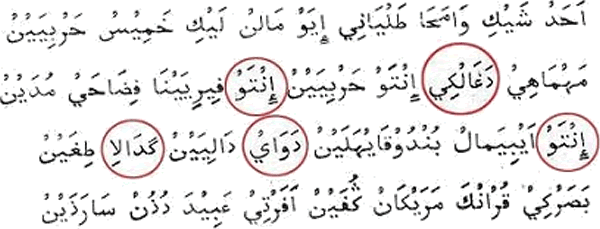
Borama/Gadabuursi alphabet
In 1933 Sheikh Abdurahman Sheikh Nuur invented another script for Somali known as Borama or Gadabuursi which was only used by the Sheikh's small circle of associates in Borama.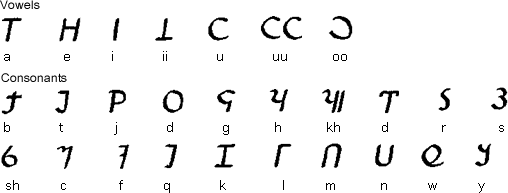
Sample text
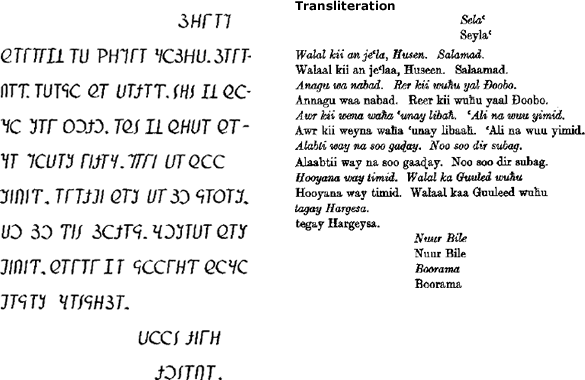
Translation
My beloved brother Huseen, Peace.I am well, the reer is at Đoobo.
The big burden camel has been eaten by a lion. 'Ali has come.
The goods have been received by us. Send us (some) ghee.
Out mother has come. Your brother Guuleed has gone to Hargeisa.
Nuur Bile,
Borama.
Somali/Osmanya alphabet (𐒋𐒘𐒈𐒑𐒛𐒒𐒕𐒀)
The Osmanya alphabet was created in between 1920 and 1922 by Osman Yusuf Kenadid (Cusmaan Yuusuf Keenadiid / عثمان يوسف), brother of the Sultan of Obbia. In Somali it is known as Farta Cismaanya / 𐒋𐒘𐒈𐒑𐒛𐒒𐒕𐒀 (Somali writing) or Far Soomaali (Somali writing). It replaced an attempt by Sheikh Uweys to devise an Arabic-based alphabet for Somali, and has in turn been replaced by the Latin orthography devised by Shire Jama Ahmed, a Somali linguist, in 1972.The Osmanya alphabet is not used much these days, though during the 1970s quite a number of people used it for personal correspondence and bookkeeping. A few books and magazines have also been published in the alphabet.
Notable features
- Direction of writing: left to right in horizontal rows.
- The names of the letters are based on Arabic letter names.
- The letters waw and ya are used to write the long vowels uu and ii respectively.
- Somali is a tonal language with three tones, which are not usually marked in the Osmanya alphabet. The tones have grammatical uses: they indicate number, gender and case.
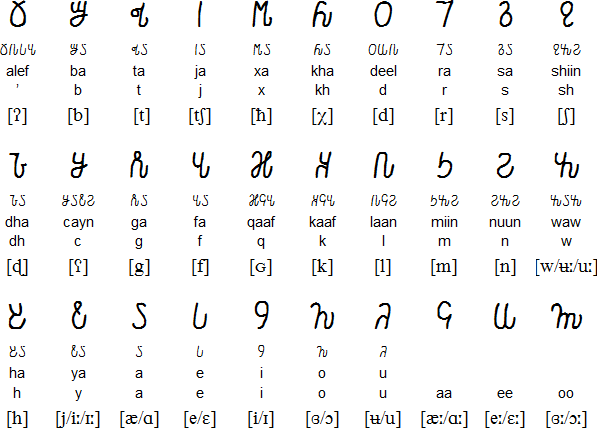
Numerals

Sample text

Kaddare alphabet
The Kaddare alphabet was invented by Sheikh Hussein Sheikh Ahmed Kaddare of the Abgaal Hawiye clan in 1952. The letters have upper forms, which are shown on the first row of the chart below, and lower case forms, which are shown on the second row.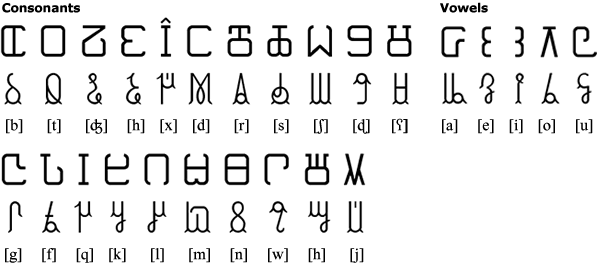
Sample text
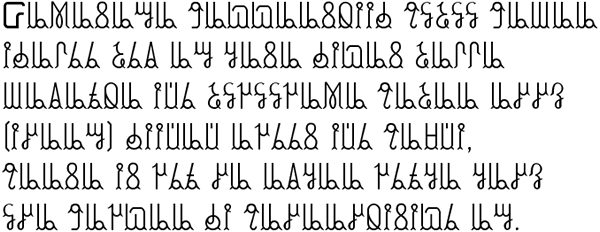
Source: http://www.skyknowledge.com/kaddare.htm - alphabet information based on research by Ian James, who is uncertain about the use of this alphabet.
Translation
All human beings are born free and equal in dignity and rights. They are endowed with reason and conscience and should act towards one another in a spirit of brotherhood.(Article 1 of the Universal Declaration of Human Rights)
http://www.omniglot.com/writing/somali.htm

Geeraar by Ali Bu'ul


Another Poem by Ugaas Nuur

Another letter from Borama


Sunday, April 22, 2018
Bacadweyne
From Wikipe
| Bacadweyne | |
|---|---|
| District | |
Coordinates:  5°20′0″N 47°54′0″ECoordinates: 5°20′0″N 47°54′0″ECoordinates:  5°20′0″N 47°54′0″E 5°20′0″N 47°54′0″E | |
| Country | |
| Region | Mudug |
| District | Hobyo District |
| Time zone | EAT (UTC+3) |
Bacadweyne is a city located in the municipality of Bacadweyne sub district in the Mudug region of Somalia. It is situated in the Hobyo District. Bacadweyne City is an ancient city well known for Islamic education, business, and the production of natural salt. The natural salt from the Bacadweyne municipality is sold throughout Somalia and Ethiopia. There are also green zones (fertile lush lands) in certain townships governed by the municipality of Bacadweyne. Those green zones are utilized by farmers, cattle herders, and camel herders. The camel from Bacadweyne have been bought by Saudis in Saudi Arabia through the Indho Deero Companies for over twenty years. Tourists from around the world travel to Bacadweyne districts to visit the ancient city
Bacadweyne municipality is one of the main components of the Galmudug State Government.
Developments[edit]
Bacadweyne is continually developing. Bacadweyne City has a middle school, secondary school, 16 Quran memorization institutes, police station, prison, several Dahabshiil money transfer posts, skilled football (soccer) players and teams.
There is construction taking place to complete the downtown area of the city, the Bacadweyne Local Hospital, and the Bacadweyne Technical Institute. This institute will provide the following courses; agriculture, veterinary, business, Quran Science, health and nursing, electrician, languages and IT.
Bacadweyne Local Airport has been completed and is in use.
These developments were made possible by the Qubeys Surre clan members who live in North America, Europe, Kenya, Somalia, Australia, and the Middle East.
Honorable and Notable Figures[edit]
Institutions, main roads, and main streets in Bacadweyne have been named after honorable Surre and Somali figures.
Notable Figures from Bacadweyne:
Leaders
- Jimaale Hasan
- Hasan wehelye Rooble (Hasan Mataan) Leader, Revolutionist, and Nabadoon
Islamic Scholars
- Sheikh Ahmed Ishaaq Abdi
- Sheikh Mohamed Hasan Dirshe
- Sheikh Ibrahim Suulay
- Sheikh Mohamed Ali Wacays
- Sheikh Mohamed Bare Jama
- Sheikh Mohamed Saleh
- Sheikh Daud Mohamud
- Sheikh Mohammed Indhayare Afcad
Artists and Poets
- Hasan Diriye Farah, Singer and
Musician.
- Moalim Ali Guray
- Zainab Laba Dhagah,Singer
- Mohamed Galaal,Famous warrior.
- Diirshe Warsame Shirwa (Diirshe Qoonay)
- Moalim Abdulahi Idris
Clan and Tribal Leaders
- Ugaas Abdulahi Hashi
- Hasan Geedi
- Hasan Haji Omar
- Sheikh Adam Jimaale
- Haji Ali Ilay
- Dahir Afcad (Yolah Afacad)
- Haji Ali Husein
- Haji Abdi Madoobe
- Abdulahi Kooriye
- Ugaas Haji Basgodane
- Ugaas Haji Omar Qubeys
- Ugaas Haji Omar Osoble
- Ugaas Salah Abdinur Ugaas (Mohamed Ali Hareed)
- Ilmi Ahmed
- Yusuf Dhore
- Aagaan
- Alinuur Indhayare Afcad IYL
- this is not a complete list of the leaders of Bacadweyne. More yet to come -
Politicians
- Drs. Zakiya Abdi Salam
- Dr. Isaaq Hashi
- Dr. Mohamed Hasan Adam (Abdulahi Shuluh)
- Dr. Jaylani Ali Keydiye
- Mr. Mohamed Abdi Nur (Juuje)
- Mr. Asad Khalif Ahmed
- Mr. Abdulahi Ise (SYL)
Surre Dir clan members whom have contributed to the advancement, peace, and prosperity of Bacadweyne and Somalia:
- Gen. Abdi Karim Yusuf Adam (Gen. Dhagabadan)
- Sheikh Yusuf Direed
Inter-clan fighting kills 14 in central Somalia Qubeys and Habar Gidir Saleeban 2010 March 5th Reuters
MARCH 5, 2010 /
12:44 AM / 8 YEARS AGO
Inter-clan fighting kills 14
in central Somalia
MOGADISHU (Reuters) - More than a dozen people were
killed and many more were hurt when two clans clashed in central Somalia,
residents and community elders said on Friday.
The Qubeys clan and the Suleyman sub-clan of the
Habargidir clan started fighting the previous day in Amara village, 90 km north
of the pirate base town of Haradheeere. The fight was over a dispute over land
ownership.
“So far we know that 14 people died in the hostilities
between the clans and more than two dozens were injured,” Mohamud Ali an Amara
resident told Reuters by phone.
Abukar Dirshe an elder from the Qubeys clan said the
fighting was sparked by long-standing hostilities over land ownership.
“We failed to reach accord with our neighbour so this
resulted in deaths and still the area is too tense. There might be further
clashes as war preparations are underway in nearby villages,” he said.
Saturday, April 21, 2018
Monday, April 2, 2018
Attacks and Aggression of Habar Gidir Against The Bimaal Dir- Refworld.org Report
http://www.refworld.org/docid/56f399224.html
According to a report published by OODA Loop, a provider of "actionable intelligence, analysis, and insight on global security" (n.d.), the Biyomal and Digil-Mirifle both occupy the Lower Shabelle State of South-West 6 (OODA Loop 23 Mar. 2014). The same source states that "[t]he South-West 6 Digil-Mirifle leaders gained support from the Dir clan, especially the Biyomaal Elders in the Marka District of Lower Shabelle" and also that
[t]he Biyomaal Dir are in an awkward position, they have to support the South-West 6 to ensure their territories are under the Digil-Mirifle dominanted Administration, as opposed to supporting the South-West 3, which would leave them to be part of the Hawiye dominated Shabelle State. (ibid.)
In correspondence with the Research Directorate, an Associate Professor of history at the University of Pennsylvania, whose research focuses on Somali culture and society, also stated that "[m]any Rahanweyn groups in Lower Shabelle share the mistrust of the Biyomal toward the Hawiya-dominated FG [Federal Government] of Somalia and for that reason, have themselves sometimes embraced al-Shabaab as a counterweight to the government" (Associate Professor 2 Oct. 2015). Corroborating information could not be found among the sources consulted by the Research Directorate within the time constraints of this Response.
3.2 Treatment by Other Clans
According to sources, the Biyomal has engaged in conflict with the Hawiye clan (Associate Professor 2 Oct. 2015; UN 13 Oct. 2014, para. 17; Norway 18 Oct. 2013, 11). The Austrian Red Cross and ACCORD indicate that the Biyomal have faced "suppress[ion]" by the Hawiye and the Ogaden/Darood clans and have engaged in armed conflict with the Hawiye in the Lower Shabelle and Middle and Lower Juba areas (Austrian Red Cross and ACCORD 15 Dec. 2009, 18). IRIN similarly states that the Biyomal and Habargidir [Haber Gedir] clan (a sub-clan of the Hawiye Clan) have fought over territories in the Lower Shabelle region on numerous occasions, "and while the Somali government has been able to mediate between the groups, a lasting ceasefire has never been achieved" (UN 11 June 2014). According to the Associate Professor, "most of the reported violence against, and oppression of, the Biyomal in recent years has been attributed to Habr Gidr forces (primarily Ayr sub clan) who seek to assert their supremacy over the district and port of Marka" (Associate Professor 2 Oct. 2015). A report published in October 2014 by the UN Security Council's Monitoring Group on Somalia and Eritrea cites interviews with internally displaced persons in the Lower Shabelle revealing that between November 2013 and August 2014, the "killing of civilians, burning of homes and farms, rape of women, and population displacement, primarily concentrated around Janale, Marka and K50" occurred as a consequence of clan violence between the Biyomal and Habargidir (UN 13 Oct. 2014, para. 44). The US Department of State's Country Reports on Human Rights Practices for 2014 also quotes the United Nations as stating that in the Lower Shabelle region, "conflict between Biimaal and Habar Gedir militias resulted in reports of abductions and killings every week in June and July" (US June 2015, 12). Sources indicate the following instances of violence between the Biyomal and Habargidir clans:
According to the BBC, in December 2013, at least 20 people were killed and "scores … sustained various injuries" following three days of fighting between the Biyomal and Habargidir clans over control of territory in the Lower Shabelle region (BBC 16 Dec. 2013).
The Monitoring Group reports that in December 2013, "serious clashes" between the Biyomal and Habargidir clans occurred and "revenge killings occurred in several locations, leading to civilians driven from their homes, rape and other human rights violations" (UN 13 Oct. 2014, para. 32).
The Monitoring Group further indicates that on 7 May 2014, Habargidir and Biyomal militias clashed at K50 and Ceel-Wareegow (ibid., para. 37). The same source states that on 9 May 2014, "the Haber Gedir launched an attack against Biimaal militias at the outskirts of Marka" (ibid.).
IRIN reports that in June 2014, armed clashes took place between the Biyomal and Habargidir clans who were "competing for control" over Somalia's southern Lower Shabelle region (UN 11 June 2014). According to the same source, during this outbreak of violence, 30 were killed and over 250 were forced to take refuge at the bases of the African Union Mission in Somalia (AMISOM) (ibid.).
The UN Security Council reports that on 9 June 2014, "a group of Haber Gedir clan militias wearing SNA [Somali National Army] uniforms reportedly entered Marka and forced the local Biimaal administration to flee" (UN 13 Oct. 2014, para. 39). The same source states that the Biyomal "suffered 35-40 civilian casualties, including women and children, and private homes and property were looted" (ibid., para. 40).
This Response was prepared after researching publicly accessible information currently available to the Research Directorate within time constraints. This Response is not, and does not purport to be, conclusive as to the merit of any particular claim for refugee protection. Please find below the list of sources consulted in researching this Information Request.
References
Associate Professor of History, University of Pennsylvania. 2 October 2015. Correspondence with the Research Directorate.
Austrian Red Cross and the Austrian Centre for Country of Origin & Asylum Research and Documentation (ACCORD). 15 December 2009. Clans in Somalia: Report on a Lecture by Joakim Gundel, COI Workshop Vienna, 15 May 2009 (Revised Edition). Edited by Daisuke Yoshimura. [Accessed 21 Sept. 2015]
Besteman, Catherine. 31 October 2013. "Conflicting Over Resources and the Victimization of the Minorities in the South of Somalia." World Peace Foundation. [Accessed 21 Sept. 2015]
British Broadcasting Corporation (BBC). 16 December 2013. "Clan Leaders Accuse Government of 'Fuelling' Clan Fighting in Southern Somalia." (Factiva).
Colby College. N.d. "Catherine L. Besteman." [Accessed 1 Oct. 2015]
European Asylum Support Office (EASO). August 2014. EASO Country of Origin Information Report: South and Central Somalia Country Overview. [Accessed 1 Oct. 2015]
Helander, Bernhard. 1996. "Rahanweyn Sociability: A Model for Other Somalis?" African Languages and Cultures, No. 3.
London School of Economics and Political Science (LSE). N.d. Anthropology Department. "News Archive 2010-2014." [Accessed 1 Oct. 2015]
Norway. 18 October 2013. Landinfo: Country of Origin Information Centre. Somalia: Lower Shabelle. [Accessed 30 Sept. 2015]
OODA Loop. 23 March 2014. Security and Political Awareness Report. [Accessed 30 Sept. 2015]
_____. N.d. "About." [Accessed 30 Sept. 2015]
Refugee Studies Centre (RSC). July 2003. David Griffiths. Somalia. Forced Migration Online. [Accessed 21 Sept. 2015]
_____. N.d. "Forced Migration Online." [Accessed 1 Oct. 2015]
Somalia Watch. 3 January 2001. "Dr. Bernhard Helander Has Left Us (Died)." [Accessed 21 Sept. 2015]
United Nations (UN). 13 October 2014. Security Council. Report of the Monitoring Group on Somalia and Eritrea Pursuant to Security Council Resolution 2111 (2013): Somalia.. [Accessed 5 Oct. 2015]
_____. 11 June 2014. Integrated Regional Information Networks (IRIN). "Clans Clash in Somalia's Lower Shabelle." [Accessed 22 Sept. 2015]
_____. N.d. High Commissioner for Refugees (UNHCR). "Genealogical Table of Somali Clans." [Accessed 21 Sept. 2015]
United States (US). 25 June 2015. Department of State. "Somalia." Country Reports on Human Rights Practices for 2014. [Accessed 18 Sept. 2015]
World Peace Foundation. N.d. "About." [Accessed 29 Sept. 2015]
Additional Sources Consulted
Oral sources: Minority Rights Group International; Professor of anthropology at Colby College; Professor of history at the University of Pennsylvania; Professor of history at Wellesely College; Professor of international environment and development studies at Norwegian University of Life Sciences.
Internet sites, including: African Union; Afrol News; Agence France Presse; Al Jazeera; AllAfrica.com; Amnesty International; BBC; Brookings Institution; CNN; Deutsche Welle; ecoi.net; Factiva; Fragile States.org; The Globe and Mail; Governance and Social Development Resource Center; Hiiraan Online; Human Rights Watch; Joshua Project; Minority Rights Group International; The New York Times; Radio Daslan; Reuters; UCDP Conflict Encyclopedia; United Nations - UNHCR, OCHA, Refworld; The Washington Post; Woodrow Wilson International Center for Scholars; World Policy Blog.
Dabruuwe Mohamed- Beesha Dabruube Maxamed Xiniftire Wax Nooga Sheega
Unverified Writing
Qoraal aan La Hubsan
Dabruuwe Mohamed. SUBCLANS AND FAMILY TREE The Dabruuwe clan
has five major subclans, whose there mnemonics is: Rage dabruwe.Yusuf dabruuwe
Weheliye dabruuwe. also dabruuwe and bimal they are brothers tree is as
following: The Mathigaan or Madigaan is a sub subclan of Dabrube, the Subclan
of Dabruuwe and is one of the tribes that inhabits in Ethiopia and Somaliland.
Historically, the Mathigaan were mainly pastoral and farmers who separated from
other Dabruuwe in nearly 400 years ago, however, the record of written
documents and inherited information from ancestors is well reserved in lower
shabelle. The Dabrube tribes lived in different parts of somalia and Ethiopia,
but they each had their history and blood
Dabruwe.Yusuf dabruuwe Weheliye dabruuwe. also dabruuwe and
bimal they are brothers but dabruube are not part of bimaal, tree is as following: The Mathigaan or
Madigaan is a sub subclan of Dabrube, the Subclan of Dabruuwe and is one of the
tribes that inhabits in Ethiopia and Somaliland. Historically, the Mathigaan
were mainly pastoral and farmers who separated from other Dabruuwe in nearly
400 years ago, however, the record of written documents and inherited
information from ancestors is well reserved in lower shabelle. Also there is
Sarjele Dabruube they are living in
Qalalafe Ethiopia. Dabrube tribes lived in different parts of somalia and
Ethiopia, but they each had their history and blood connected.Italic text —
Preceding Dabruube
Sunday, April 1, 2018
Ahmed Hassan Gabobe-Minister for Endowment and Religious Affairs And later Somali Minister of Agriculture------ Gadsan/ Bimaal / Dir
Ahmed Hassan Gabobe is a Somali politician. He belongs to
the Bimal subclan of the Dir. He is the Minister of Justice and Religious
Affairs of Somalia, having been appointed to the position on 27 January 2015 by
Prime Minister Omar Abdirashid Ali Sharmarke.[1]
Information on the Gadsan clan's relationship with Somali authorities was scarce among the sources consulted by the Research Directorate within the time constraints of this Response.
Sources report that, in 2015, Ahmed Hassan Gabobe, was named Minister of Justice and Religious Affairs (Waagacusub Media 29 Jan. 2015) or Minister for Endowment and Religious Affairs (WardheerNews.com 28 Jan. 2015). The webpage of Somalia's Ministry of Agriculture and Livestock indicates that Gabobe is currently the Somali minister of agriculture (Somalia n.d.).
According to a 2015 article by Waagacusub Media, a source of "independent news and information in East Africa" (Waagacusub Media n.d.b), based in the Netherlands (Waagacusub Media n.d.a), Gabobe belongs to the Gadsan clan (Waagacusub Media 29 Jan. 2015). The same source states that Gabobe is a former "[i]slamist [e]xtremist and a member of the Cancelled Islamic Union Court" (Waagacusub Media 29 Jan. 2015). According to the same source, Gabobe is "linked [to] participating in fights in Defow, Kabhanley and Lower Shabelle" (Waagacusub Media 29 Jan. 2015). Corroborating information could not be found among the sources consulted by the Research Directorate within the time constraints of this Response.
XAFIISKA RA’IISAL DOWLADDA SOOMAALIYA
WAARADDA BEERAHA
SOMALI MINISTRY OF AGRICULTURE AND LIVESTOCK
Mudane Axmed Xasan Gaboobe Wasiirka Wasaaradda Beeraha
H.E. Ahmed Hassan Gabobe is the Somali Minister of Agriculture
Mudane Cabdicasiis Saalax Carmaan Wasiir Ku-xigeenka Wasaaradda Beeraha
H.E. Abdiasis Salah Osman is the Deputy Minister of Agriculture.
Prime Minister Omar Abdirashid has named 20 new crop ministers 2015 Nominated Ministers and Their Clans
Nominated Ministers and Their Clans
January
28, 2015
Prime
Minister Omar Abdirashid has named 20 new crop ministers last night, here we
publish their names along with their clans.
There
are 4 major clans and half in the Somali power sharing system, they are Dir,
Darod, Digil & Mirifle , Hawiye and Others (0.5)
Dir
1. Mohamed
Omar Arte : Deputy Prime Minister , Minister of Labor, Youth and Sports ( Dir,
Isak, Habar Awal)
2. Ahmed
Hassan Gabobe : Minister of Justice and Religious Affairs ( Dir , Biyomaal)
3. Abdisalan
Hadliye Omar : Minister for Foreign Affairs ( Dir, Godabiirse)
4. Noor
Farah Hersi : Minister For Constitutional Affairs ( Dir, Isak, Habar-Yonis)
Others
1. Hassan
Ahmed Modey : Minister for Commence and Industry ( Jarer Weyn)
2. Sahra
Mohamed Ali Samatar : Minister for Women and Human Rights ( Tumal)
3. Fahad
Yasin Haji Dahir : Minister for Ports and Marine Transport ( (Rer Aw Hassan)
4. Saed
Hussein Eid : Minister for Livestock, and Pasture ( Meheri, Arab Salah)
Hawiye
1. Abdirahman
Mohamed Husen : Minister for Interior and Federal Affairs (Habar Gidir)
2. Abdirahman
Yusuf Hussein Aynte : Minister of Planning and International Cooperation (
Murusade)
3. Mohamed
Moktar Ibrahim : Minister of Fisheries and Marine Resources ( Gal Je’el)
4. Abdirizak
Omar Mohamed : Minister of Petroleum, Water and Natural Resources ( Hawadle)
Digil
and Mirifle
1. Mohamed
Adan Ibrahim (Fargeti) : Finance Minister (Rahanweyn, Disow)
2. Ali
Hassan Osman : Minister for Agriculture (Rahan Weyn)
3. Hawo
Hassan Mohamed : Health Minister (Rahanweyn, Hadamo)
4. Salah
Sheikh Osman Mose : Minister of Public Works and Resettlement ( Digil, Gelledi)
Darod
1. Abdikadir
Sheik Ali Dini : Defense Minister ( Marehan)
2. Guled
Hussein Kasim : Information and Telecommunication Minister ( Ogaden)
3. Ali
Ahmed Jama (Jangali) : Minister for Air Transport And Aviation (Dhulbahante)
4. Khadra
Bashir Ali : Education Minister (Lelcase)
Goobjoog
News
Position of the Gadsan Clan in the Somali Dir Clan Hierarchy- Beesha Gadsan iyo Qoraalo
Gaadsan
Gaadsan, a subclan of Biyomaal, is one of the largest clans of the Dir. Their homelands are divided amongst three countries: Ethiopia, Somalia and Kenya. In Ethiopia, Gaadsan clan reside in three woredas: Liben (Jarrati, Waladaya, Doolow and Guuredhamole), Gode (Iimey and Boola), and Misraq Gashamo (Nusdariiq, Marsin, Kabtinuur and Qabridhare). The Gaadsan in Somalia mainly live in Bakool, Gedo and the Lower Juba Regions. In Kenya there is a third division of Gaadsan, known as Gaadsan-Kenya, the brother of Wardey Clan (subclan of Madaxweyne Dir). Both Gadsan and Wardey have settled on the largest and wealthiest lands of Somali Kenya such as Bangal, Garseeni, and Hoolla.Correction: The Gadsan are a subclan of the Biimal Saleeban who are in turn part of Dir. Gadsan/ Saleeban/Bimaal/Hiniftire /Mahe/ Dir .
http://irb-cisr.gc.ca/Eng/ResRec/RirRdi/Pages/index.aspx?doc=457322
Somalia: Information on the Gadsan clan, including history, cultural practices, locations, occupations and position in the clan hierarchy; relationship with other clans, authorities and Al Shabaab (2015-December 2017)
Research Directorate, Immigration and Refugee Board of Canada, Ottawa
1. Position of the Gadsan Clan in the Clan Hierarchy
Sources indicate that the Gadsan [Gaadsen, Gadsen, Gaadsan] clan is a sub-clan of the Dir clan (ITPCM Dec. 2013, 14; Somalia CEWERU Dec. 2013, 15). Sources indicate that the Dir are nomadic pastoralists (ITPCM Dec. 2013, 14; Solomon 2015, 41), and are regarded as being "noble" (Solomon 2015, 41).
According to sources, there are four main clans in Somalia: the Dir, Darood [Darod], Hawiye, and Isaaq [1] (Gundel 15 Dec. 2009, 12; EU Aug. 2014, 43-44). A December 2013 article published by the International Training Programme for Conflict Management (ITPCM) [2] states that, according to various persons of Somali origin interviewed in November 2013 in Nairobi, the Hawiye and Darood are major clans in Somalia (ITPCM Dec. 2013, 14). The same source explains that the Hawiye and Darood control Somalia's "political development" and that all the other clans, including the Dir, "rally around these two for state power and control" (ITPCM Dec. 2013, 14).
According to sources, the Gadsan clan is a direct sub-clan of the Dir clan (Somalia CEWERU Dec. 2013, 15; Farah Oct. 2016, 8). Other sources indicate that the Gadsan clan is a sub-clan of the Biyomal [Biyamal, Biamal, Biimal] clan, itself a sub-clan of the Dir clan (Waagacusub Media 29 Jan. 2015; Center for Political Studies 28 May 2017, 131). In a 2009 working paper written for the African Studies Centre Leiden (ASCL) [3] in the Netherlands, Jan Abbink, an "anthropologist-historian" with research focusing on the history and cultures of the Horn of Africa (ASCL n.d.a), states that the Gadsan clan is a sub-clan of the Hiniftire clan, itself a sub-clan of the Maahe, which is a sub-clan of the Dir clan (Abbink 2009, 17-19). A 2002 paper written by Guido Ambroso, while he was a field repatriation officer for UNHCR, states that the Gadsan clan is "considered by some informants as a sub-clan of the Bimal and by most others a clan on its own merit" (Ambroso Mar. 2002, 9, emphasis in original). For further information on the Biyomal clan, see Response to Information Request SOM105305 of October 2015.
2. Locations of the Gadsan Clan
In his paper, Ambroso indicates that the Gadsan clan is found in southern Somalia and in eastern Ethiopia (Ambroso 2002, 6, 69).
Sources indicate that the Gadsan clan in Somalia is found in the Gedo region (Gutale 2008, 78; CRD May 2004, 15; Sharamo 2012, 198), a southwestern Somali region that borders Kenya and Ethiopia (Sharamo 2012, 198). Sources indicate that the Gedo region is also inhabited by the Marehan and Ogaden sub-clans of the Darood, the Dagodi [Degodia], the Ajuran and the Bantu sub-clan of the Jarer [Jareer] (CRD May 2004, 15; Sharamo 2012, 198). In his doctoral dissertation on politics and struggles of peacemaking in Somalia, submitted in 2012 to the Graduate Faculty of George Mason University, Roba D. Sharamo [4] explains that the Gedo region is
[q]uite a volatile region [and that] the major challenges to the peace and stability [of the region] were due to insecurity, rivalry and power struggles between SNF [Somalia National Front]/SRRC [Somali Reconstruction and Restoration Council] (that controlled the Luuq, Dolow and Beledhawa [d]istricts) and SNF (that controlled the El-Wak, Bardera, Burdubo and Gerbeharu [d]istricts); and external conflicts with RRA [Rahanweyn Resistance Army]/SRRC from the Bardeere [d]istricts. The region also experienced frequent communal clashes because of competition over the use of pasturelands. (Sharamo 2012, 198)
Corroborating information could not be found among the sources consulted by the Research Directorate within the time constraints of this Response.
A 2016 document on famine in Somalia published by the Feinstein International Center, a research and teaching centre at Tufts University that promotes the use of evidence and learning in operational and policy responses to protect people affected by humanitarian crises (Tufts University n.d.), quotes a farmer from the Jamame district, in the south of the Jubba [Juba] valley, as stating that there are about 700 families in his village who belong to various clans, "[t]he largest [being] the Biyomaal followed by the Darood (Majerteen and Ogaden) and the Gaadsan" (Feinstein International Center Jan. 2016, 8, 30). Similarly, according to a 2012 draft document on community reconciliation in the Somali Gedo and Jubba regions, written by the Somalia NGO Consortium, an association of NGOs that acts as a "coordinated voice" for local and international NGOs invested in development and humanitarian work in Somalia (Somalia NGO Consortium n.d.), the Gadsan clan is present in the Lower Jubba region in Somalia (Somalia NGO Consortium 29 Mar. 2012, 6).
According to a 2017 report on clans in Somalia, prepared by the International Business & Technical Consultants, Inc. (IBTCI), "an international development consulting company" (IBTCI n.d.), and submitted to the United States Agency for International Development (USAID), the Gadsan clan also inhabits the Bakool region in Somalia, specifically the Rabdhure district (IBTCI 20 Sept. 2017, 56). The same source states that the Bakool region is also inhabited by, among others, the Rahanweyne [Rahanweyn] clan, the "Ogden's Aulihan," Reer Afgab sub-clans, Buurashadley, the Aulihan and the Jejele clan (IBTCI 20 Sept. 2017, 56). According to a 2001 report by the UN, the Gadsan clan also live in the Raaso [Rasso, Raso] region in Ethiopia (UN 29 May 2001, 13). Corroborating information could not be found among the sources consulted by the Research Directorate within the time constraints of this Response.
3. Employment and Occupations of the Gadsan Clan
In a 1999 book on pastoralism and politics in Somalia, Ioan Myrddin Lewis, a former professor at the London School of Economics and Political Sciences who specialised in Somali Studies (WardheerNews.com 3 June 2014), indicates that the Gadsan clan is of a religious or priestly lineage of Somali descent (Lewis 1999, 224). The same source explains that priestly lineages in Somalia are "nominally 'men of God,' possessed of blessing by definition, rather than necessarily learned in the Shariah" (Lewis 1999, 224). According to the same source, clans that are of priestly lineages, such as the Gadsan clan, have a higher proportion of sheikhs [Arab chiefs] than "other 'warrior' lineages and clans" (Lewis 1999, 224).
In a 2000 paper on castes and minorities in Somalia, Mohamed Mohamed-Abdi, while he was an anthropologist at the French National Research Institute for Sustainable Development (IRD), explains that the Gadsan clan, along with the Dir clan, belongs to the waranle cast, the members of which [translation] "are holder[s] of land and of water supplies," are "in general" nomadic pastors, and breed dromedaries, cattle, goats and sheep (Mohamed-Abdi 2000, 135). The same source further explains that, among the clans belonging to waranle, some, including the Gadsan, assume religious functions (Mohamed-Abdi 2000, 135).
Information on the history and cultural practices of the Gadsan clan could not be found among the sources consulted by the Research Directorate within the time constraints of this Response.
4. Treatment of the Gadsan Clan and Relations to Other Somali Actors
According to the Armed Conflict Location & Event Data Project (ACLED), a project that collects data on "the dates and locations of all reported political violence and protest event in over 60 developing countries in Africa and Asia" (ACLED n.d.), the Gadsan clan has been involved in the following incidents of "non-state armed conflicts":
- on 5 March 2008, according to local informants, militias of the Gadsan clan and of the Macalin-Weyne sub-clan engaged in a battle, which did not lead to a change of territory, in Luuq in the Gedo region (ACLED 2016, event 84 549);
- on 28 April 2008, according to local informants, a battle occurred between militias of the Gadsan clan and of the Macalin-Weyne sub-clan in Luuq in the Gedo region (ACLED 2016, event 84 740). According to the same source, the battle did not lead to a change of territory (ACLED 2016, event 84 740).
- on 4 May 2008, according to Agence France-Presse (AFP) and the Associated Press (AP), militias of the Gadsan clan and of the Rahanweyn-Moalim Weyne sub-clan engaged in a battle over land dispute in Luuq in the Gedo region (ACLED 2016, event 84 771). The same source states that the battle did not lead to a change in territory, and that 12 people died in the 12-hour conflict between the two militias (ACLED 2016, event 84 771);
- on 13 August 2013, a gunman from a Madhiban clan militia wounded two civilians, one of whom belonged to the Gadsan clan, with gunshots in Qardho in a private dispute (ACLED 2016, event 93 329).
Corroborating information could not be found among the sources consulted by the Research Directorate within the time constraints of this Response.
4.1 Relationship with Al-Shabaab
Information on the Gadsan clan's relationship with Al Shabaab was scarce among the sources consulted by the Research Directorate within the time constraints of this Response.
According to ACLED, on 17 November 2015, gunmen, revealed to be from al Shabaab, "shot and killed" a civilian member of the Gadsan clan in Galkacyo in the Mudug region [north-central Somalia] while the victim was at a wedding event (ACLED 2016, event 99 594). The same source states that the motivation for the killing was "unknown" (ACLED 2016, event 99 594). Corroborating information could not be found among the sources consulted by the Research Directorate within the time constraints of this Response.
4.2 Relationship with Somali Authorities
Information on the Gadsan clan's relationship with Somali authorities was scarce among the sources consulted by the Research Directorate within the time constraints of this Response.
Sources report that, in 2015, Ahmed Hassan Gabobe, was named Minister of Justice and Religious Affairs (Waagacusub Media 29 Jan. 2015) or Minister for Endowment and Religious Affairs (WardheerNews.com 28 Jan. 2015). The webpage of Somalia's Ministry of Agriculture and Livestock indicates that Gabobe is currently the Somali minister of agriculture (Somalia n.d.).
According to a 2015 article by Waagacusub Media, a source of "independent news and information in East Africa" (Waagacusub Media n.d.b), based in the Netherlands (Waagacusub Media n.d.a), Gabobe belongs to the Gadsan clan (Waagacusub Media 29 Jan. 2015). The same source states that Gabobe is a former "[i]slamist [e]xtremist and a member of the Cancelled Islamic Union Court" (Waagacusub Media 29 Jan. 2015). According to the same source, Gabobe is "linked [to] participating in fights in Defow, Kabhanley and Lower Shabelle" (Waagacusub Media 29 Jan. 2015). Corroborating information could not be found among the sources consulted by the Research Directorate within the time constraints of this Response.
This Response was prepared after researching publicly accessible information currently available to the Research Directorate within time constraints. This Response is not, and does not purport to be, conclusive as to the merit of any particular claim for refugee protection. Please find below the list of sources consulted in researching this Information Request.
Notes
[1] A 2011 article written by Abdi Ismail Samatar, a professor at the University of Minnesota who specializes in Somalia and in the relationship between democracy and development (University of Minnesota n.d.), indicates that the Digil and the Rahanweyne are also among the largest clans in Somalia (Samatar Mar. 2011, 50).
[2] The ITPCM, a part of the Institute of Law, Politics and Development, an interdisciplinary research centre on law, economics and political science of the Sant'Anna School of Advanced Studies (Sant'Anna n.d.a), is an organization that helps "enhance international expertise for the peaceful management of conflicts" and "contributes to the development of political, socio-economic and cultural strategies for lasting peace" (Sant'Anna n.d.b).
[3] The ASCL is a "knowledge institute that undertakes research and is involved in teaching about Africa and aims to promote better understanding of and insight into historical, current and future developments in Africa" (ASCL n.d.b).
[4] Roba D. Sharamo is a Commissioner at the National Cohesion and Integration Commission (NCIC) of the Republic of Kenya who "has over 16 years of experience in international development, diplomacy and conflict analysis and resolution (George Mason University n.d.).
References
Abbink, Jan. African Studies Centre, Universiteit Leiden. 2009. The Total Somali Clan Genealogy (second edition).
Armed Conflict Location and Event Dataset (ACLED). [2016]. Clionadh Raleigh, Andrew Linke, Havard Hegre and Joakim Karisen. "All Africa Files." ACLED Version 7 (1997 - 2016). (Standard File) [Accessed 11 Dec. 2017]
Ambroso, Guido. March 2002. Clanship, Conflict and Refugees: An Introduction to Somalis in the Horn of Africa. [Accessed 27 Nov. 2017]
African Studies Centre Leiden (ASCL), Universiteit Leiden. N.d.a. "Jan Abbink." [Accessed 7 Dec. 2017]
Gundel, Joakim. 15 December 2009. Clans in Somalia: Report on a Lecture by Joakim Gundel, COI Workshop Vienna, 15 May 2009 (Revised Edition). Edited by Daisuke Yoshimura. [Accessed 5 Dec. 2017]
Center for Political Studies, University of Michigan. 28 May 2017. Zhukov, Yuri, Christian Davenport, and Nadiya Kostyuk. xSub: Actor Dictionaries Codebook. [Accessed 28 Nov. 2017]
Center for Research and Dialogue (CRD). May 2004. Conflict Analysis: South-Central Somalia. [Accessed 4 Dec. 2017]
European Union (EU). August 2014. European Asylum Support Office (EASO). South and Central Somalia - Country Overview. [Accessed 5 Dec. 2017]
Farah, Qasim Hersi. October 2016. The Stability/Sustainability Dynamics: The Case of Marine Environmental Management in Somalia. PhD thesis. York University, Canada. [Accessed 28 Nov. 2017]
Feinstein International Center. Tufts University. January 2016. Nisar Majid, Guhad Adan, Khalif Abdirahman, Jeeyon Janet Kim and Daniel Maxwell. Narratives of Famine: Somalia 2011. [Accessed 4 Dec. 2017]
George Mason University. N.d. School for Conflict Analysis and Resolution. "Roba D. Sharamo." [Accessed 12 Dec. 2017]
Gutale, Abdirahman Mohamed. 2008. The Alliance Framework: A Micro-Level Approach to Diagnose Protracted Conflict in South Central Somalia. Master's Thesis. University of Kansas, United States. [Accessed 27 Nov. 2017]
International Business & Technical Consultants, Inc. (IBTCI). 20 September 2017. Sarah Wood, Anna Patterson, Jama Egal, Michael Oloo and Lucas Malla. Transition Initiatives for Stabilization Plus Baseline Assessment Final Report. [Accessed 28 Nov. 2017]
International Business & Technical Consultants, Inc. (IBTCI). N.d. "About IBTCI." [Accessed 11 Dec. 2017]
International Training Programme for Conflict Management (ITPCM). December 2013. "Somalia: Clan and State Politics." ITPCM International Commentary. Vol. IX No. 34. [Accessed 28 Nov. 2017]
Lewis, Ioan Myrddin. 1999. A Pastoral Democracy: A Study of Pastoralism and Politics Among the Northern Somali of the Horn of Africa. Oxford: LIT Verlag Münster-Hamburg and James Currey Publishers.
Mohamed-Abdi, Mohamed. 2000. "Les bouleversements induits par la guerre civile en Somalie : castes marginales et minorités." Autrepart. Vol. 15.
Samatar, Abdi Ismail. 2011. "Debating Somali Identity in a British Tribunal: The Case of the BBC Somali Service." Bildhaan: An International Journal of Somali Studies. Vol. 10. [Accessed 11 Dec. 2017]
Sant'Anna School of Advanced Studies. N.d.a. "Institute of Law, Politics and Development." [Accessed 5 Dec. 2017]
Sant'Anna School of Advanced Studies.. N.d.b. "Institute of Law, Politics and Development: ITPCM." [Accessed 5 Dec. 2017]
Sharamo, Roba D. 2012. Predatory Politics and Struggles of Peacemaking in Somalia. PhD thesis. George Mason University, United States. [Accessed 4 Dec. 2017]
Solomon, Hussein. 2015. Terrorism and Counter-Terrorism in Africa. Edited by Stuart Croft. Hampshire: Palgrave Macmillan.
Somalia Conflict Early Warning Early Response Unit (Somalia CEWERU). December 2013. From the Bottom Up: Southern Regions - Perspectives Through Conflict Analysis and Key Political Actors' Mapping of Gedo, Middle Juba, Lower Juba, and Lower Shabelle. [Accessed 24 Nov. 2017]
Somalia NGO Consortium. 29 March 2012. Analytical Framework for Supporting Community Reconciliation in Gedo-Jubba. [Accessed 28 Nov. 2017]
Tufts University. N.d. Feinstein International Center, Friedman School of Nutrition Science and Policy. "About Us." [Accessed 5 Dec. 2017]
Waagacusub Media. 29 January 2015. "Somalia: Newly-Appointed Cabinet, Their Background and Group Affiliates." [Accessed 6 Dec. 2017]
Waagacusub Media. N.d.b "About." [Accessed 6 Dec. 2017]
WardheerNews.com. 28 January 2015. "Somalia's Prime Minister Names New Cabinet." [Accessed 6 Dec. 2017]
WardheerNews.com. 3 June 2014. "I. M. Lewis 1930-2014: A Great Tree Has Fallen." [Accessed 11 Dec. 2017]
The Bimaal or Bimal, official name: Jamal, (Somali: Biimaal,
Beesha Biimaal, Jamal, or Beesha Jamal, Arabic: بنو
جمال, بنو بيمال) is one of the sub-clans of the major Dir
clan family. This clan is widely known for leading a resistance against the
colonials in southern Somalia for decades which can be compared to the war of
the Sayyid in northern Somalia.[1] [2] [3]
The Biimaal mainly lives in Southern Somalia, the Somali region of
Ethiopia, which their Gaadsen sub-clan mainly inhabits and in the NEP region of
Kenya.[4] [5]
Overview
The Bimal are the dominant clan in Lower Shabelle and make
up the majority, but they also live in the NEP region of Kenya and especially
in large numbers inhabit the Somali region of Ethiopia. The Bimal a belicose
clan that was known for their struggle and long resistance against the
Italians. The Bimal formed their own organization during the war, the Southern
Somali National Movement (SSNM), which name is derived and inspired by the
Somali National Movement, which the Bimal also gave their support and funding
too. Formally allied with Aideed, the chairmain of the SSNM, Colonel Abdi
Warsame in 1993 broke with General Aideed and took part of the SSNM with him
when he aligned himself with Ali Mahdi.[6] [7]
As Dir sub-clan, the Bīmāli have immediate lineal ties with
the Gadabuursi, Surre (Abdalle and Qubeys), the Issa, the Bajimal, the Bursuk,
the Madigan, the Gurgura, the Garre (the Quranyow sub-clan to be precise as
they claim descent from Dir), Gurre, Gariire, other Dir sub-clans and they have
lineal ties with the Hawiye (Irir), Hawadle, Ajuraan, Degoodi, Gaalje'el clan
groups, who share the same ancestor Samaale.[8] [9] [10] [11] [12] [13] [14]
History
Merca was established in the 7th century by the Bimaal clan.
The first Somalis arrived in the city in the 6th century and gained control of
the city and trade of the region.[15]
The Bimaal are pastoralists. They were also successful merchants and
traders in the 19th century.[16] The
Bimaal have proved in the past to be a bellicose clan, not only against their
neighbours, but also against Italian colonial encroachment.[17] More than a century ago they had engaged in
multiple wars with the Geledi clan. The Bimaal violently resisted the
imposition of colonialism fought against the Italian colonialists in a
twenty-year war known as the Bimaal revolt in which many of their warriors
assassinated several Italian governors.[16] [18]
Subscribe to:
Comments (Atom)
Blog Archive
- ► 2012 (418)
-
▼
2018
(250)
-
▼
April
(20)
-
►
Apr 22
(7)
- Inter-clan fighting kills 14 in central Somalia Qu...
- Bacadweyne
- BARNAAMIJ: BEESHA QUBEYS OO DOORATAY GUDOOMIYE DAH...
- Calema Saarka Ugaaska Besha ahmed Farax Qubays Hob...
- beelwaynta gaadsan shirkii iskaashi muqdisho somalia
- Beelaha direed ee somalia biyomaal iyo jiido iyo q...
- cabdi good:samaroon waa qabiika kaliyee somali la ...
-
►
Apr 22
(7)
-
▼
April
(20)
